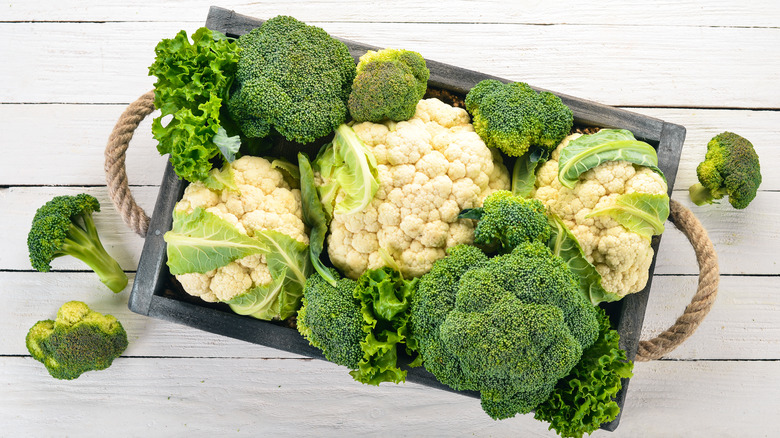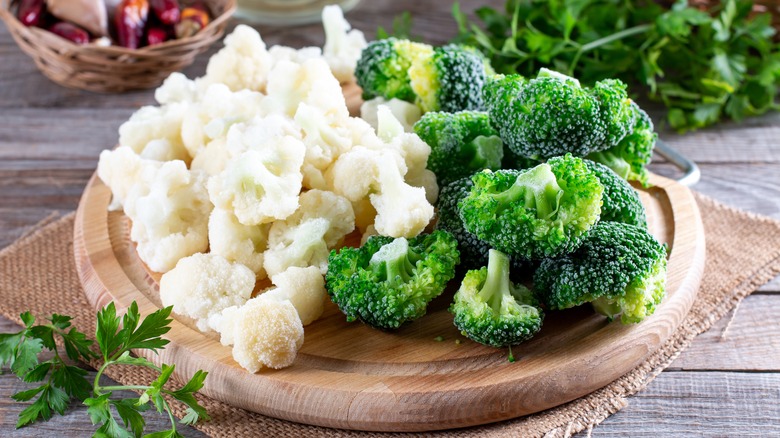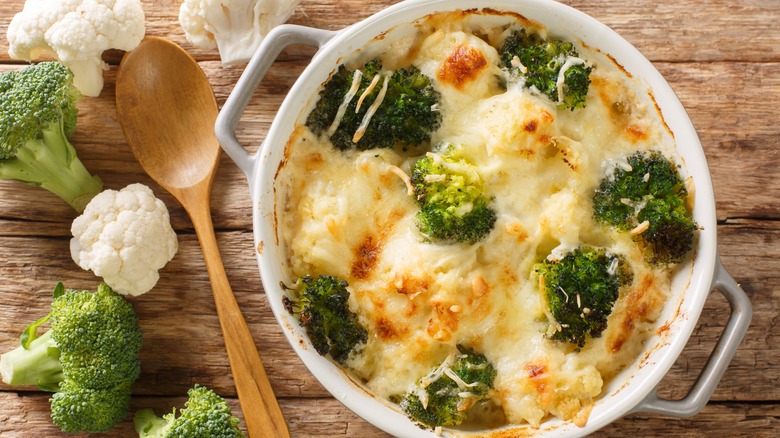The Difference Between Broccoli And Cauliflower, Beyond Color
Despite one being green and the other white, broccoli and cauliflower are often lumped together. Maybe it's because they are both cruciferous vegetables in the Brassica family – along with arugula, bok choi, Brussel sprouts, cabbage, collard greens, horseradish, kale, mustard greens, radishes, rutabaga, turnips, and watercress. Or perhaps, with their color differences notwithstanding, it's that they both have a similar appearance consisting of tightly packed buds formed into a rounded head of florets.
Although there are indeed many similarities between the two, there are also quite a few differences — everything from how they taste, to their nutritional content, and how to prepare and eat them — make broccoli and cauliflower unique in their own right.
Let's start with their most obvious difference: their flavor. While they can sometimes be used interchangeably and show up in world cuisines from Indian to Middle Eastern and beyond, they do not taste the same. The chlorophyll that develops in broccoli is responsible for more than just its green color, it also gives it a distinctly leafy flavor, often described as grassy, herbaceous, and earthy. Cauliflower on the other hand has a milder flavor, which comes across as nutty and slightly sweet. While their textures are somewhat alike too (hard when raw but softened when cooked), their particular characteristics make them suitable for a variety of different dishes and recipes.
Broccoli and cauliflower have different nutritional profiles
While both vegetables are highly nutritious, this is also where they show significant variations. Both are packed with vitamins and minerals while low in calories and carbohydrates. The amounts of these nutrients are different in each, so including both in a balanced eating plan can help you to make the most of all their benefits.
For example, one cup of raw, chopped broccoli provides 31 calories, 6 grams of carbs, 2.5 grams of fiber, and 2.5 grams of protein. The same amount of cauliflower has 27 calories, 5 grams of carbs, and 2 grams each of fiber and protein. Broccoli is very high in vitamin C with 90% of the daily value while cauliflower contains a lesser yet still robust amount at 57%. There's a big difference in their vitamin K content too, with 77% in broccoli but only 14% in cauliflower. Conversely, cauliflower is higher in vitamin B6 with 12%, and broccoli with 9%.
Other vitamins, minerals, micronutrients, and antioxidants are abundant in both as well, with broccoli having higher levels of riboflavin, manganese, niacin, phosphorus, vitamin E, and magnesium — while cauliflower offers more folate, potassium, and pantothenic acid. Both contain equal amounts of copper and thiamine at 5% of the daily value for each.
The tastiest ways to cook these cruciferous vegetables
Aside from their individual dietary perks, broccoli and cauliflower are widely consumed simply because they're both delicious. In fact, according to a Green Giants press release, broccoli was consistently named as America's favorite vegetable in its annual survey every year since 2018, with corn overtaking it for the first time in 2023. Although broccoli lost its top spot for that year, it still ranked as the winner for tastiest vegetable.
Easy to make into different dishes and preparations, both can be eaten raw, or steamed, boiled, baked, roasted, grilled, sauteed, fried, etc. Raw broccoli adds a nice crunch to salads or when eaten as a snack with dips like hummus, tzatziki, or guacamole. Roasting it with a touch of oil, salt, and pepper until it starts to crisp brings out the best of its flavor. It's excellent in stir-fries or a copycat version of a Chinese takeout-style beef and broccoli recipe.
With a head of cauliflower being more densely packed than that of broccoli, it lends itself to being marinated and roasted whole, or cut into individual slices to make vegetarian "steaks." When pureed, cauliflower can be made into a creamy base for soups, and it's regularly used along with plant-based milk as an alternative to cheese sauce. It has also gained popularity in keto diet plans as a replacement for rice, potatoes, or pasta — and you can even learn how to make cauliflower pizza crust.



